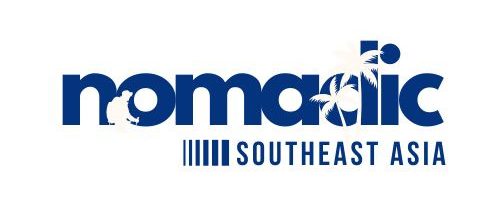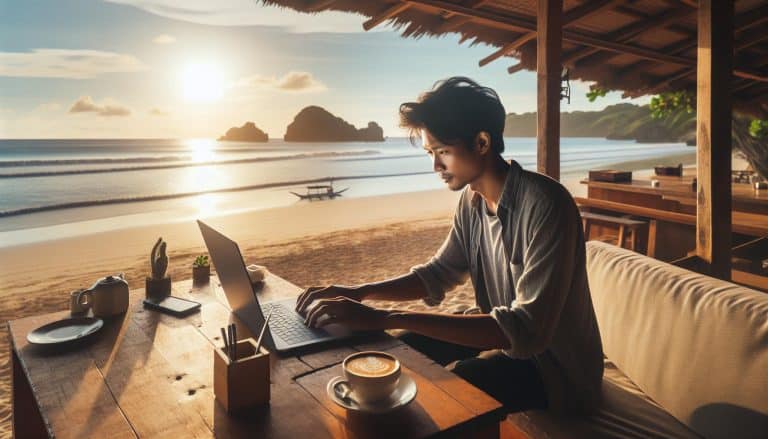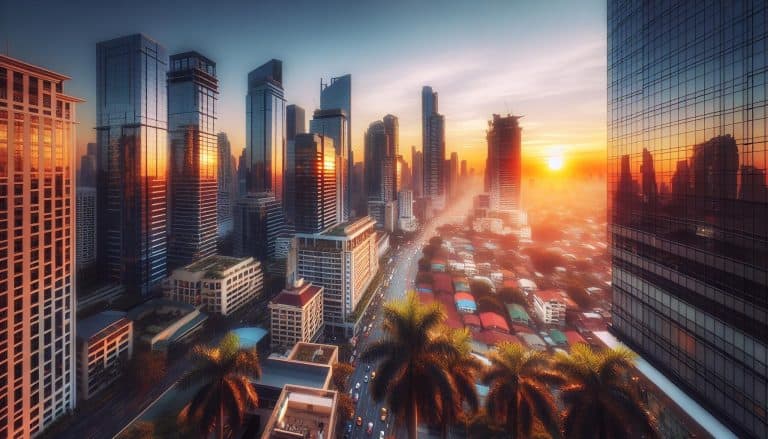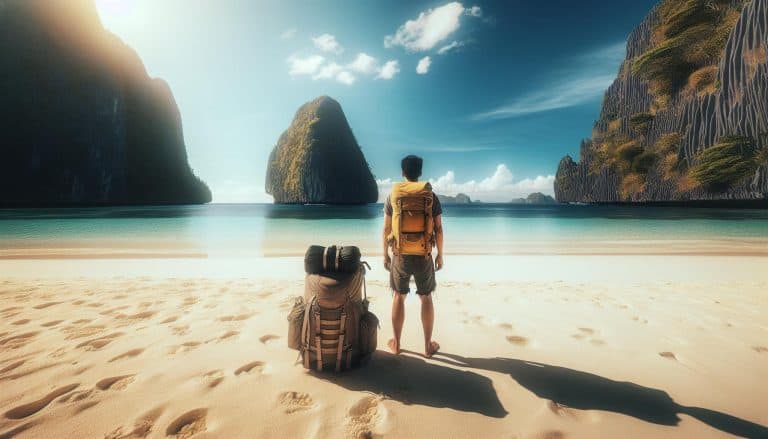Best Time To Visit The Philippines: 2025 Guide
Nomadic Southeast Asia contains affiliate links and is a member of the Amazon Services LLC Associates Program. If you make a purchase using one of these Amazon links, I may receive compensation at no extra cost to you. See my Disclosure Policy for more information.

If you’re considering visiting the Philippines in 2025, you’re in for a delight.
This Southeast Asian country is a stunning archipelago of islands is famous for its world-class beaches, rich culture, and warm friendly people who make feel right at home.
So, how do you make your trip epic?
We’ll discuss the Best Time To Visit The Philippines so you can miss the heavy rain and soak up that gorgeous sunshine.
And we’ll give it to you straight about what the weather is really like, so you can pack smart.
This guide is full of tips to make you get the most out of your experience.
We’re talking insider information to make your trip hassle-free and unforgettable.
Ready to begin and organize your Philippine paradise dream getaway?
Let’s begin!
Key Takeaways
- The peak season to go to the Philippines is the dry season, between November and May, when sunny skies and nice beaches await you.
- If you are a surfing enthusiast, head there between August and November when the waves are highest.
- January and April, are a great time to planning your trip to experience lively cultural festivals Filipino style.
- Every area experiences different weather patterns, so make sure to consider your destination while planning your visit.
- Plan financially wisely by applying off-season traveling prices and finding inexpensive activities in order to gain the most from your trip.
Introduction to Visiting the Philippines in 2025
The Philippines is a perfect place for visitors searching for amazing shores, deep culture, and memorable experiences.
Whether you love jumping between islands, snorkeling, or discovering lively towns, this warm paradise offers something for all.
But what’s the right time to go? Getting to know the weather and planning ahead can be the make-or-break of your journey.
Why Visit the Philippines?
There are more than 7,000 islands in the Philippines, and each has something unique to offer. Here is list of the all the Philippines Islands by region.
From Boracay’s white sandy shores to Palawan’s stunning scenery, there is plenty of nature to explore.
Adventure enthusiasts can surf in Siargao, dive in Tubbataha Reef, or swim with whale sharks in Oslob.
Alongside nature, the nation abounds in history & traditions.
Capitals like Manila and Cebu have a combination of old-world history, exciting bazaars, and present-day places to visit.
The Filipinos even have a fabled tradition of warm hospitality so that people travel with an effortless sense of freedom wherever they visit.
For a very well-planned trip, Nomadic Southeast Asia offers detailed traveling guides, e.g., hints on saving, planning itineraries, and insider tips.
Overview of the Climate and Seasons in the Philippines
It’s hot weather here in the Philippines, so it’s warm all year round. But knowing the seasons will assist you in planning an amazing holiday.
The Philippines has two big seasons: dry & wet, and storm season falling on top of the rainy season.
Every season has different kinds of adventures, so the ideal time to take would be depending on what you wanna do.
- Dry Season (November to May)
- This is ideal for beach vacations, island hopping, and outdoor adventures.
- Sunny afternoons & blue skies are in store, ideal for exploring.
- Rainy Time (June to October)
- Although some places have intense storms & typhoons, this period also has fewer crowds and lower costs.
If you’re going on a vacation, checking weather forecasts on AccuWeather (Philippines) or Pagasa might be able to spare you from unforeseen weather problems.
If you knew the seasons & planned ahead, you could have gotten the most out of your trip to this marvelous place.
Dry Season (November to May)
Dry season is the most ideal time to visit if you like sunny days, blue skies, & excellent beach weather. Dry season is divided into:
- Chilly Dry (Nov – Feb): Weather is good, best for going to destinations like Manila, Cebu and Vigan.
- Hot Dry (Mar to May): Hottest time of the year, best for island hopping in Palawan, Boracay, and Siargao.
Since this is the high tourist season, advance booking of flights & hotels is advisable.
Rainy Season (June to October)
The rainy season translates to regular rain & occasional storms, but not everything is gloomy. Some benefits of visiting destinations during this period are:
- Fewer tourists – Enjoy popular spots without the crowds.
- Value-for-money prices – Flights as well as stay are comparatively more affordable in prices.
- Scenic landscapes – Cebu’s waterfalls as well as the rice terraces of Banaue are most beautiful.
Don’t forget if you find yourself traveling at that time, watch out for updates on weather conditions on Pagasa & organize indoor activities like visits to museums or food excursions.
Typhoon Season: What You Need to Know
Typhoon time crosses over with the wet months, hitting its highest point from July to September. Even though not every place gets hit, it’s key to:
- Monitor weather forecasts using AccuWeather (Philippines) or Pagasa.
- Have a flexible itinerary in case of delays.
- Avoid island destinations if a storm is approaching.
By understanding the seasons, you can plan smarter and enjoy the Philippines no matter when you visit!
Best Months to Visit The Philippines Based on Activities

This will guide you to figure out the best month to visit Philippines 2025. The perfect moment to go to the Philippines relies on what you’re looking to do.
No matter if you love going to the beach, riding waves, celebrations, or underwater exploring, every activity has a best time.
Organizing your visit during these times makes sure you have the greatest time.
Beach and Island Hopping (December to May)
If you are thinking about white sandy shores, super-clear water, & bright blue skies, go between December to May.
That’s the dry time, which makes it great for checking out islands such as:
- Palawan – Visit El Nido and Coron for stunning lagoons and limestone cliffs.
- Boracay – Famous for its powdery white sand and vibrant nightlife.
- Siargao – A laid-back island with hidden beaches and rock pools.
Since this is the busiest time, reserve places to stay soon.
Surfing Season (August to November)
The Philippines boasts some of the best surfing spots in Southeast Asia, led by Siargao.
Its famous ‘Cloud 9‘ wave makes Siargao attractive to surfers around the world.
But even amateurs can surf at places like La Union and Baler, which have constant swells and lively surf scenes.
It’s every Digital Nomad Philippines’s fantasy, when you can catch up on work with the best wave-chasing in the world.
Off the breaks, there are warm people, good food, and a lively surf culture
The largest waves are between August & November, generally in the Cloud 9 Surfing Cup in September. 🤙
Other awesome surf locations are:
- Baler – A beginner-friendly surf town with consistent waves. 🏄
- La Union – A popular weekend getaway for surfers near Manila. 🏄
Check surf forecasts on SURFLINE to plan your sessions.
Festivals and Cultural Events (January to April)
If you enjoy road parades, tunes, and traditional parties, go during the festival time. A few of the largest happenings include:
- Sinulog Festival (January, Cebu) – A grand street party with colorful costumes and dancing.
- Ati-Atihan Festival (January, Aklan) – Known as the “Mother of All Philippine Festivals.”
- Panagbenga Festival (February, Baguio) – A flower festival with stunning floats and performances.
Festivals bring in massive groups, so reserve places to stay early.
Diving and Snorkeling (March to June)
The greatest time for scuba diving & snorkeling is in the warm, dry months (March through June) when the sea is still & you can see clearly.
Best places to dive include:
- Tubbataha Reefs (March to June) – A UNESCO-listed marine park with incredible biodiversity.
- Apo Reef – The second-largest coral reef system in the world.
- Moalboal – Famous for the sardine run and sea turtles.
For dive conditions and bookings, check PADI Travel.
By planning your trip around these activities, you’ll experience the best of what the Philippines has to offer!
Regional Weather Patterns and Best Times to Visit
The Philippines consists of three big regions: Luzon, Visayas & Mindanao, each having its own climate patterns.
Even though the nation has a tropical weather, some places feel cooler, while others get more rain.
Understanding the right time to go to each area helps you organize a better trip.
Luzon: Manila, Baguio, and Banaue
Luzon, the largest island, has a mix of urban cities, mountain retreats, and historical sites.
- Manila
- Best to visit from December through April when it’s not rainy & not too warm.
- The city might feel sticky, so set up indoor plans like museums and food trips around noon.
- Baguio
- Called the “Summer Capital of the Philippines,” Baguio has chilly weather all year.
- The best period to go is November through May, skipping the strong rains between June & October.
- Banaue
- Well-known for its rice steps, Banaue is ideal to see from February through April when the paddies are bright green.
Visayas: Cebu, Bohol, and Boracay
The Visayas region is home to some of the best beaches and diving spots in the country.
- Cebu
- A place to visit all year, though the top months to go are December till May for exploring islands & seeing whale sharks in Oslob.
- Bohol
- Visit between January and May to see the Chocolate Hills and enjoy clear waters for snorkeling.
- Boracay
- Best between November and May when the island has clear skies & peaceful waters.
- Stay away from July – October, since heavy rains might mess up beach fun.
Mindanao: Siargao, Davao, and Camiguin
Mindanao is a paradise for adventure seekers and nature lovers, with surf spots, waterfalls, and volcanoes.
- Siargao
- The top season for riding waves is August through November, while March till May is perfect for exploring islands.
- Davao
- Travel between December and May for sunny weather & an opportunity to climb Mt. Apo, the nation’s tallest mountain.
- Camiguin
- Best between March and June when the climate is great for visiting warm springs, cascades & sandbars.
By knowing the climate in every area, you could schedule your journey at the best moment & get the most out of your experience.
Travel Tips for the Philippines

Planning your journey to the Philippines helps a lot.
From reserving tickets to keeping safe, here are some key travel tips to make your 2025 trip easy & worry-free.
Booking Flights and Accommodations
Flights to the Philippines can get pricey, especially during peak season (December to May).
To save money:
- Book in advance – Flights are cheaper when booked 3-6 months in advance. Use resources like Google Flights to track prices.
- Travel mid-week – Tuesdays and Wednesdays usually have lower fares.
- Consider budget airlines – Cebu Pacific and AirAsia offer low-cost domestic flights.
Booking through Agoda or Booking.com might also secure great discounts.
Packing Essentials for Different Seasons
The Philippines is warm all year round, but intelligent packing has something to do with when you are traveling:
- Dry season (November to May) – Light clothing, sunscreen, shades, and hat for the heat.
- Rainy season (June to October) – Light rain jacket, water-resistant backpack, and quick-drying clothing.
- Island hopping – Reef-safe sunscreen, water shoes, and dry bag are must-haves.
Safety and Health Considerations
Safety first while traveling.
Remember these things:
- Stay weather-aware – Check Pagasa for typhoon advisories.
- Get insured – Travel insurance from companies like World Nomads covers medical situations and trip cancellations.
- Beware of scams – Avoid super friendly strangers offering “free trips” or deals that sound too good to be true.
- Stay hydrated – The sun can be intense, so consume plenty of water and bring a refillable bottle.
With early planning & regularity with these ideas, you’ll have a secure, exciting and memorable vacation to the Philippines in 2025.
Budgeting and Cost Considerations
Traveling to the Philippines can be cheap or costly, depending on when you travel & how you plan it.
Whether you’re an economy traveler or a high-end tourist, if you know prices beforehand, you can save money & enjoy yourself.
Peak vs. Off-Peak Travel Prices
The method in which you travel and when you travel affect prices for flights, hotels, and vacations.
- Peak season (December to May)
- Be ready for more expensive flights & hotel stays, especially in popular places like Boracay & Palawan.
- Early booking might make you spend less.
- Off-season (June – October)
- Flight tickets & hotel stays are cheaper, but some places may get a lot of rain.
- If you can tolerate some rain, it’s a good time to go.
Saving on Transportation and Accommodation
Traveling around the Philippines need not cost an arm and a leg.
Here’s how to save money:
- Flights – Monitor prices using Google Flights and book ahead.
- Ferries and buses – 2GO Travel and Ceres Bus have economic island and city travel.
- Accommodations – Sleep in hostels, inns, or Airbnb for cheaper options.
Websites like Agoda & Booking.com provide fantastic discounts.
Budget-Friendly Experiences and Activities
You don’t need to spend a fortune to enjoy yourself in the Philippines.
Some low-cost or free activities include:
- Beaches – The majority of the best beaches, like Nacpan Beach in Palawan, are free to visit.
- Hiking – Hike Mt. Pulag, Osmeña Peak, or Taal Volcano for a small entrance fee.
- Neighborhood markets – Enjoy tasty & cheap street food at joints like Larsian over in Cebu or Salcedo Market around Manila.
By smart budgeting, you can enjoy an amazing trip without breaking your budget!
Final Thoughts
Timing your visit to the Philippines in 2025 is all about timing.
Whether you’re soaking up the sun on Boracay’s soft white shores, snorkeling in Palawan’s very crystal-clear waters, or experiencing the country’s festive holidays, knowing the best time to go makes all the difference.
In short, dry months (Nov to May) are perfect for beachgoers, island hopping, and outdoor activities, while wet season (June to Oct) has lush landscapes and fewer tourists—just watch out for storms.
Surfing enthusiasts, Siargao’s surf is best from Aug to Nov, and for culture, try festivals like Sinulog & Panagbenga that make the country vibrant from Jan to Apr.
Regardless of when you travel, preparation is crucial.
Booking in advance flights & accommodations, research on the weather, and acting wisely with one’s finances will make your journey an enjoyable experience.
If, however, you’re seeking not just a holiday—maybe more of a vehicle for making the lifestyle of the traveler a sustainable reality—then Nomadic Southeast Asia is truly a treasure of a resource.
From travel tips to easy step-by-step instructions on how to get into the Travel Blogging Business, it has great guides for anyone who wants to venture into Southeast Asia and make money out of their interests.
So, when is your next adventure? If you’re a first-time adventurer or an experienced explorer, the Philippines awaits to amaze you.
Pack your bags, prepare early, and get ready for an experience of a lifetime. 🚀🌴
Frequently Asked Questions (FAQs)
What is the best time to travel to the Philippines?
The best time to travel to the Philippines is during the dry season, from November to May. This period is characterized by pleasant weather, and it is ideal for enjoying beaches and island exploration.
Are there any months which are preferable for some activities?
Yes. December to May is great if you want a good time at the beach and island-hopping. August to November is ideal when surfing. For cultural events, visit between January and April if you’re interested.
How does weather vary across different regions in the Philippines?
The climate also differs quite a lot from region to region. Luzon, for instance, is colder in the mountains, while Visayas and Mindanao are hotter. Don’t forget to refer to local weather forecasts if you plan on visiting.
What do I bring when going to the Philippines?
Essentials for packing include light clothing, swimsuits, sunscreen, and bug spray. If you will be there during rainy season (June to October), don’t forget a raincoat and rain boots.
How do I save money when traveling in the Philippines?
To be thrifty, look for traveling in the off-season, using public transportation, and dining at local restaurants. Further, seek low-cost accommodations and activities that cost nothing, including hiking and touring local markets.



